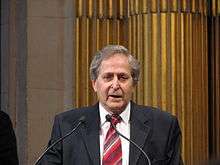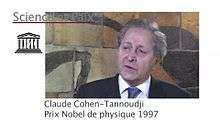Claude Cohen-Tannoudji
| Claude Cohen-Tannoudji | |
|---|---|
|
Claude Cohen-Tannoudji | |
| Born |
1 April 1933 Constantine, Algeria |
| Nationality | French |
| Fields | Physics |
| Institutions |
Ecole normale supérieure University of Paris |
| Doctoral advisor | Alfred Kastler |
| Doctoral students |
Serge Haroche Jean Dalibard |
| Notable awards |
Young Medal and Prize (1979) Lilienfeld Prize (1992) Matteucci Medal (1994) Harvey Prize (1996) Nobel Prize in Physics (1997) |
| Spouse | Jacqueline Veyrat (m. 1958)[1] |
| Children | 3 |
Claude Cohen-Tannoudji (born 1 April 1933) is a French physicist. He shared the 1997 Nobel Prize in Physics with Steven Chu and William Daniel Phillips for research in methods of laser cooling and trapping atoms. He is still an active researcher, working at the École Normale Supérieure in Paris.
Early life
Cohen-Tannoudji was born in Constantine, Algeria, to Algerian Jewish parents Abraham Cohen-Tannoudji and Sarah Sebbah.[2][3][4][5] When describing his origins Cohen-Tannoudji said: "My family, originally from Tangier, settled in Tunisia and then in Algeria in the 16th century after having fled Spain during the Inquisition. In fact, our name, Cohen-Tannoudji, means simply the Cohen family from Tangiers. The Algerian Jews obtained the French citizenship in 1870 after Algeria became a French colony in 1830."[6]
After finishing secondary school in Algiers in 1953, Cohen-Tannoudji left for Paris to attend the École normale supérieure.[6] His professors included Henri Cartan, Laurent Schwartz, and Alfred Kastler.[6]
In 1958 he married Jacqueline Veyrat, a high school teacher, with whom he has three children. His studies were interrupted when he was conscripted into the army, in which he served for 28 months (longer than usual because of the Algerian War). In 1960 he resumed working toward his doctorate, which he obtained at the end of 1962.
Career

After his dissertation, he started teaching quantum mechanics at the University of Paris. His lecture notes were the basis of the popular textbook, Mécanique quantique, which he wrote with two of his colleagues. He also continued his research work on atom-photon interactions, and his research team developed the model of the dressed atom.
In 1973, he became a professor at the Collège de France. In the early 1980s, he started to lecture on radiative forces on atoms in laser light fields. He also formed a laboratory there with Alain Aspect, Christophe Salomon, and Jean Dalibard to study laser cooling and trapping. He even took a statistical approach to laser cooling with the use of stable distributions.[7]
His work there eventually led to the Nobel Prize in physics in 1997 "for the development of methods to cool and trap atoms with laser light",[8] shared with Steven Chu and William Daniel Phillips. Cohen-Tannoudji was the first physics Nobel prize winner born in an Arab country.
Awards

- 1979 - Young Medal and Prize, for distinguished research in the field of optics.
- 1993 - Charles Hard Townes Award
- 1994 - honorary doctorate from the Faculty of Science and Technology at Uppsala University, Sweden [9]
- 1996 - CNRS Gold medal
- 1997 - Nobel Prize, for the development of methods to cool and trap atoms with laser light.
- 2010 - Legion of Honour
Selected works
The main works of Cohen-Tannoudji are given in his homepage.[10]
- Claude Cohen-Tannoudji, Bernard Diu, and Frank Laloë. 1973. Mécanique quantique. 2 cols. Collection Enseignement des Sciences. Paris. ISBN 2-7056-5733-9 (Quantum Mechanics. Vol. I & II, 1991. Wiley, New-York, ISBN 0-471-16433-X & ISBN 0471164356).
- Claude Cohen-Tannoudji, Gilbert Grynberg and Jacques Dupont-Roc. Introduction à l'électrodynamique quantique. (Photons and Atoms: Introduction to Quantum Electrodynamics. 1997. Wiley. ISBN 0471184330)
- Claude Cohen-Tannoudji, Gilbert Grynberg and Jacques Dupont-Roc, Processus d'interaction photons-atomes. (Atoms-Photon Interactions : Basic Processes and Applications. 1992. Wiley, New-York. ISBN 0471625566)
- Claude Cohen-Tannoudji. 2004. Atoms in Electromagnetic fields. 2nd Edition. World Scientific. Collection of his most important papers.
See also
References
- ↑ Notable twentieth century scientists: Supplement - Kristine M. Krapp - Google Books. Retrieved 2013-03-09 – via Google Books.
- ↑
- ↑
- ↑ Francis Leroy (13 Mar 2003). A Century of Nobel Prize Recipients: Chemistry, Physics, and Medicine. p. 218.
- ↑ Arun Agarwal (15 Nov 2005). Nobel Prize Winners in Physics. p. 298.
- 1 2 3 Claude Cohen-Tannoudji. "Claude Cohen-Tannoudji - Autobiographical". NobelPrize.org. Retrieved 13 February 2015.
- ↑ Bardou, F., Bouchaud, J. P., Aspect, A., & Cohen-Tannoudji, C. (2001). Non-ergodic cooling: subrecoil laser cooling and Lévy statistics.
- ↑ "The Nobel Prize in Physics 1997". nobelprize.org. The Nobel Foundation. 1997. Retrieved 14 December 2014.
- ↑ http://www.uu.se/en/about-uu/traditions/prizes/honorary-doctorates/
- ↑ "Claude Cohen-Tannoudji" (in French). École normale supérieure. Retrieved 14 December 2014.
External links
| Wikimedia Commons has media related to Claude Cohen-Tannoudji. |
| Wikiquote has quotations related to: Claude Cohen-Tannoudji |
- His research group
- His lecture notes (in French)
- Autobiography for the Nobel Prize ceremony (on which this article is based)
